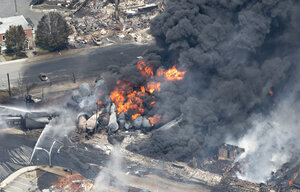Despite grim July, train accidents are rare
Train travel remains one of the safest forms of transportation, even more so than automobile travel.

Smoke rises earlier this month from railway cars that were carrying crude oil after derailing in downtown Lac Megantic, Quebec. July has seen three devastating train derailments in Canada, France, and Spain, with scores killed in each. But overall, railway travel remains one of the safest in the world.
Paul Chiasson/The Canadian Press/AP/File
This summer, images of traffic derailments have become all too familiar. Three major accidents this month alone have resulted in photographs and video of twisted metal and black smoke more frequently associated with the battlefield than the world's railways.
Earlier in July, a train derailment and subsequent explosion in Lac-Mégantic, Quebec, resulted in at least 42 deaths. Less than a week later, a train crash in France, just south of Paris, left six people dead and 20 injured. Most recently, 78 people were killed Wednesday night in Spain after a high-speed train derailed in Spain. This was the first accident to strike the country’s high-speed system, which US President Barack Obama once called a model for a potential US version.
But even after several high-profile, catastrophic train accidents, rail is still a preferred means of transport. And the reason why is simple: Though train accidents are quite dangerous, rail transport is actually relatively safe.
According to statistics from International Union of Railways, which collects information on train accidents in Europe, fewer than 2,000 people died in train accidents in 2011, down from 2,371 fatalities five years earlier. And 94 percent of those deaths were not passengers, but rather third parties outside the train, such as trespassers.
Compared to automobile fatalities, these numbers are very low. According to the American Public Transportation Association (APTA), between 2003 and 2008 there were more than 1.4 passenger deaths for every 100 million miles driven in motor vehicles. For rail transit, however, there were less than 0.1 fatalities for the same amount of distance.
“When you look at the whole body of data, [train safety] really is spectacular,” says Arthur Guzzetti, vice president of policy for the APTA. But he adds, “it is not perfect, and [the accident in Spain] was tragic.”
Accidents still happen, and when they do they are devastating, due to the enormous mass and velocity of a train. In 1998, the Eschede accident in Germany killed 101 people when a crack in one of the wheels caused a derailment. And in 2011, two high-speed trains collided in Wenzhou, China, killing 40 people. And the recent derailment in Spain was allegedly the fault of human error.
But these accidents are extremely rare. For example, the first high-speed rail system was implemented in Japan in 1964, and so far they have had no accidents.
“There is going to be operator error to some degree,” says Mr. Guzzetti. However, “the whole body of data, evidence, and experience … shows that [the Spanish derailment] was a significant incident in an overall safe operation.”

